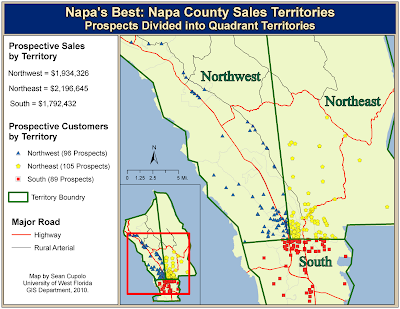The posted maps were created for the University of West Florida On-Line GIS certification program class, Special Topics in GIS (GIS 4930) as part of the Project 4 Analyze Week assignment focusing on using GIS and Transportation. In the weeks assignment we had to create sales territories for three sales people for the Napa's Best wine company based on the prospects identified in the previous weeks maps.
The criteria for dividing the prospects into sales territories were:
1. Each territory should contain about 1/3 of the prospects with no more then a variance of two prospects between territories.
2. The level of sales potential for each territory should not vary more than +/- 5% from the average of the territories.

The first method for choosing territories required manually selecting sites using the GIS selection tools until the required number of sites was achieved and it was verified that the sites total sales potential met that criteria. The method is straightforward and easily allows for creating three balanced territories that appear on the map as distinct geographic areas.

Two alternate methods for choosing territories were explored. The first method focused on trying to divide the sales area into quadrants that were divided somewhat equally with prospects also divided equally. The dividing lines for the quadrants are straight lines that do not attempt to preserve the prospect counts specifically, rather by having the line split prospects in a best fit manner that maintains as much as possible the proper division of prospects. Unfortunately, I could not seem to get the dividing lines to fit close enough and had a split of 89-96-105.

The final method focused on using existing roadways as borders for the territories. The map only displays the major roads, but in order to make sure the prospect split was correct, minor roads were incorporated, particularly in the population center where most of the prospects are concentrated. The splits for this layer were the best ones from a prospects and sales potential perspective at 96-97-97 split for prospects and a deviation from the average of the territories of no more than 2.3%, well under the 5% threshold. Additionally, setting up the territories using roadways allowed for consideration of travel times and routing of sales calls such that certain prospects were shifted to a territory based on the travel path to them.
For these reasons, it was recommended that Napa's Best choose the third option, territories based on roadway borders to set up the sale territories in Napa County.
The final map displays the recommended territory layout and contains some additional graphing to help illustrate why this method was best.












